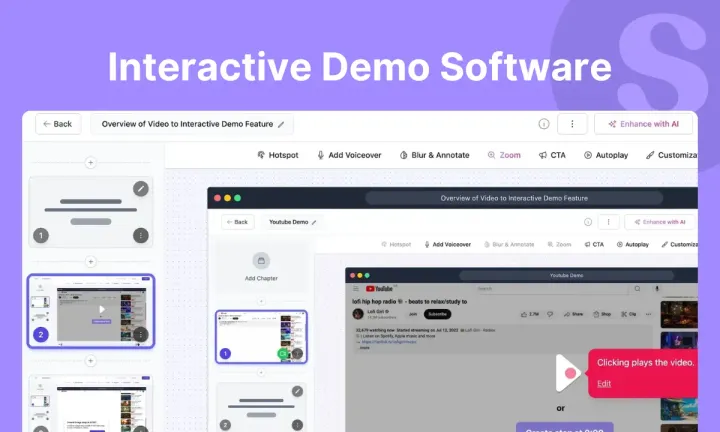Have you ever wondered about the purpose and importance of a demo guide in peer-to-peer learning? Are you curious about how to create a meticulously organized user guide tailored for your colleagues? Look no further as we embark on a journey to unveil the answers you seek.
According to a recent survey conducted by Deloitte, a significant number of organizations, approximately 60%, utilize peer-to-peer education as a crucial component of their training programs. This approach is employed to bolster onboarding processes, foster a collaborative work culture, and enable the seamless exchange of skills among employees. The study further highlights the positive impact of peer-to-peer learning in increasing employee engagement, knowledge retention, and overall productivity.
To optimize the collaborative learning experience, coworkers rely on demo guide to facilitate the process. But what exactly are demo guide applications, and what benefits do they bring? Equally important, how can you craft a well-structured demo guide specifically designed for training your peers effectively?
Let us embark on a detailed exploration to address these pressing questions one by one.
Exploring the Concept of Demo Guide for Peer-to-Peer Learning and what benefits do they bring?
In the realm of peer-to-peer learning, a demo guide serves as a valuable asset, equipping employees with instructional materials prepared by their colleagues.
Demo software come in diverse formats such as cheat sheets, knowledge bases, PDF tutorials, step-by-step presentations, how-to guides, training manuals, and more. These formats serve as valuable training resources that team members can leverage during employee-led workshops, action learning sets, peer-mentorships, onboarding buddy programs, and similar collaborative initiatives.
Let's delve into the key advantages of demo guide for fostering a culture of collaborative learning and training in the workplace.
Enhancing employee retention: Boosting employee retention is crucial, as insufficient training has been associated with increased turnover rates, prompting employees to leave their positions within the initial year. However, organizations can mitigate this risk by offering comprehensive demo guides to team members. These guides ensure high-quality workplace education, fostering an environment that enhances employee retention.
Empowering employees: By utilizing demo guides, employees are empowered to share their expertise and skills with their peers, fostering a culture of collaboration and ongoing learning. This empowerment not only enhances morale but also actively promotes the exchange of knowledge within the organization.
Promoting higher job satisfaction: The presence of clear and succinct instructions in demo guide enables colleagues to acquire new skills with confidence and clarity. This, in turn, enhances job performance, contributes to overall job satisfaction, and creates a more productive and fulfilling workday.
Facilitating flexible training: Demo guide are highly adaptable to various needs and purposes within a peer-to-peer learning environment. They can be modified to address cross-departmental training requirements, ensuring the transferability of skills across different jobs and departments.
Reducing training costs: Leveraging the expertise of coworkers to create demo guide offers a cost-effective approach to employee training. By utilizing digital, self-paced formats, organizations can avoid the expenses associated with hiring corporate trainers or coaches.
To create an effective peer-to-peer learning demo software, consider the following best practices.
i) Identify pain points and knowledge gaps, understand the challenges employees face while working within your organization. Keep your demo software instructions clear, concise, and easy to understand.
ii) Incorporate visuals, screenshots, and real-world examples into your demo software to improve engagement and comprehension. Visual elements make information easier to understand and retain. catchy visuals such as images, videos, GIFs, and other graphical elements have the power to alleviate the monotony of text and elevate the learning experience for your peers.
ii) Provide step-by-step guidance. Break down complex tasks into a series of clear instructions to streamline the learning process and accelerate skill acquisition.
iii) Encourage colleagues to share their contributions to the demo guide, fostering a collaborative atmosphere that encourages continued development. This ensures the relevance and validity of the guide.
iv) Carefully review and revise the demo guide as tools, processes, or best practices evolve. Regular updates maintain its accuracy and usefulness.
Once you have created a demo guide, distribute it among your colleagues for review and gather valuable feedback from peers.
By implementing these tips, you can develop compelling demo guide that maximize the benefits of peer-to-peer learning, taking collaborative workplace training to new heights.
Demo guides for informal learning play a crucial role in cultivating a collaborative environment and promoting ongoing skill development among employees.
Supademo is a user-friendly tool that effortlessly streamlines the creation of professional and polished guides. It offers a simplified interface that doesn't necessitate any specialized technical knowledge or skills. By utilizing Supademo, you can optimize and enhance the knowledge-sharing process within your team.
Start experiencing the numerous benefits of Supademo today!
Sign up for free and document your demo guides in a matter of minutes.



